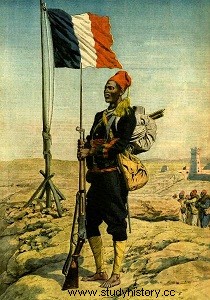
Senegalese skirmishers are a body of soldiers formed within the French colonial Empire in 1857, the main element of the "Black Force".
In 1914-1918, around 200,000 "Senegalese" from the AOF fought in the French ranks, including more than 135,000 in Europe. 30,000 of them died there, and many returned injured or disabled.
The troops raised in North Africa, theoretically non-black, in fact also included black Africans (15,000 blacks in Morocco, for about 30,000 soldiers), who served under the orders of Mangin.
The origins of skirmishers
In 1857, Louis Faidherbe, Governor General of French West Africa, lacking manpower from mainland France in the new territories of Africa, to meet the needs generated by the colonization phase, created the corps of Senegalese riflemen. .The decree was signed on July 21, 1857 in Plombières-les-Bains by Napoleon III. Until 1905, this body included slaves bought back from their local masters, then prisoners of war and even volunteers with a wide variety of origins. Non-commissioned officers generally come from the local aristocracy.
Senegalese skirmishers are not necessarily Senegalese, they are recruited from all over Africa.
Some Senegalese, born French in the four full-time French communes of Senegal, are not considered skirmishers, but equality with whites was not yet the rule.
During the First World War
Many Africans died on the French battlefields of the First World War. Jacques Chirac, as President of the French Republic, in his speech for the 90th anniversary of the Battle of Verdun, mentioned 72,000 combatants from the former French Empire who died between 1914 and 1918, "Moroccan infantrymen, Senegalese Tunisian skirmishers , Algerians, soldiers from Madagascar, Oceania, Indochina (Cochinchina, Anamite skirmishers). Marine infantry porpoises »
After the Franco-German war of 1870, in full preparation for the 1914-1918 war, in 1910, Colonel Mangin in his book "La force noire" described his conception of the colonial army, even as Jean Jaurès published on his side "The new army" which expresses the need to look elsewhere for soldiers that the French could not provide in sufficient numbers due to a drop in the birth rate.
Difficulties in recruiting
If the proconsuls representing France in Africa quickly proposed several thousand men who were volunteers or recruited with methods close to those of previous centuries, revolts against enlistment broke out further from large cities in Africa, including the first of importance among the Bambaras of Mali, near Bamako, lasted about 6 months, from the spring of 1915 to November 1915, announcing other more tenacious revolts, some of which were very harshly repressed in June 1916 by France, which had its artillery fired on ten fortified villages, killing several thousand civilians, including women and children who refused to surrender.
Like many later mutinies, these resistances were hidden so as not to provide additional elements to the German propaganda which denounced the behavior of France in Africa, including the fact that it brought in "barbarians" from Africa to make them fight on the European fronts.
Certain French administrators, and the colonists involved in the colonial trade also slowed down the calling up of young Africans, believing that they were thus being deprived of a young labor force which was not abundant at the time in Africa.
During World War II
As during the previous conflict, France used the colonies during the Second World War as a reservoir of men for its army. And just like during the First World War, they are accused of abuses by the Germans. It was for wanting to protect one of these units that Jean Moulin was arrested in June 1940.
In France there is a military cemetery, the Senegalese Tata, in Chasselay, Rhône department, where the Nazi armies massacred one of these units. Eveline Berruezo and Patrice Robin made a film of it in 1992, entitled "Le Tata".
On December 2, 1944, a few dozen Senegalese riflemen were massacred by the French army at the Thiaroye camp in Senegal. Ousmane Sembène made a film of it in 1988, entitled Camp de Thiaroye.
After the Second World War:the crystallization of pensions
In 1959, then in 1960, the French Parliament adopted a so-called "crystallization" mechanism, i.e. the freezing of the debt contracted by mainland France, by freezing the value of the pension points at the value reached during the accession to independence of the countries, of which the former skirmishers were nationals. After almost 50 years of litigation, and after the release of the film Indigènes evoking the role of North African troops in Europe in 1943-1945, the French Parliament finally voted on November 15, 2006 to revalue the pensions of soldiers from the former colonies in under the 2007 veterans budget. "84,000 colonial veterans of 23 nationalities should benefit", if they come forward, knowing that most soldiers of the First World War are already dead.
